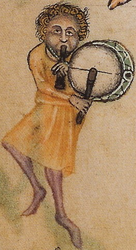Tabor (instrument)
 Pipe and tabor player, c. 1325–1335 | |
| Classification | Unpitched percussion instrument |
|---|---|
| Related instruments | |
A tabor, tabret, (Welsh: Tabwrdd), Tambour De Provence, or Tambourin (Provencal) is a portable snare drum typically played either with one hand or with two drumsticks. The word "tabor" is simply an English variant of a Latin-derived word meaning "drum"—cf. French: tambour, Italian: tamburo[1] It has been used in the military as a marching instrument, and has been used as accompaniment in parades and processions.
Construction[]

A tabor has a cylindrical wood shell, two skin heads tightened by rope tension, a leather strap, and an adjustable snare. The single snare can be made from gut, silk, or rough hemp.[2] Each tabor has a pitch range of about an octave: the larger the tabor, the lower the pitch. It is played by just one short conical stick, made from bone or ivory,[2] which usually strikes the snare head. The tabor is suspended by a strap from the forearm, somewhere between the elbow and wrist. When played, the shell is virtually parallel with the ground.[1] In Spain, a deep drum is used for a tabor by pipe and taborers, and in England a shallow tom tom is sometimes used, although medieval icons of pipe and tabor usually display a large shallow tabor similar in shape to a bodhrán.
Usage[]
The tabor is most widely known as accompaniment for the pipe and other small flutes, such as the flageolet,[2] and most famously as the percussive element in the "pipe and tabor" one-man band configuration.[1] The tabor is beaten on the snare side.
Georges Bizet scored for the tabor drum in his L'Arlesienne Suite No. 2, and Aaron Copland calls for it in his Appalachian Spring and El Salón México. Darius Milhaud has been named one of the foremost composers of modern (mid-20th century) music for the tabor by Morris Goldenberg. His Suite Provancale calls for tabor played along with two other drums by a single player. In classical repertoire the tabor is usually played with two sticks, as many pieces call for speeds that are unwieldy for a single hand. In many cases composers' scores have been mistranslated with the erroneous call for tambour de basque or tambourine when the piece was originally intended for tabor. Parts written for tabor are usually very simple and feature straight eight notes or another easy repetitive pattern.[2]
History[]

The tabor is classified as a membranophone and dates back to the Medieval period in Europe.[3] Hand-written documents and engravings are some of the earliest recordings of this instrument.[3][4] The size of these early tabors ranged approximately 11-12 inches in diameter and 4-10 inches in width/depth.[3][4] These 13th century tabors were thus larger across their diameter, but the tabor continued to evolve with time and eventually some were almost even in diameter and width.[4] The 16th century design of the tabor changed to the opposite proportions from the earlier models with the width being greater.[4]
Tabors were constructed of wood for the body of the drum with the stretched membrane made out of some type of skin.[3] It was primarily used for the outdoors.[3] The tabor is a precursor to the side drum.[5]
The common way of playing the tabor together with the pipe produced the effect of a single person band.[6][7] It was often played for dancing, and was sometimes played as a small ensemble with the bagpipes.[3][5] Since the tabor was used to accompany dancing, regular rhythmic beats were common for this instrument.[4] The tabor was used to accompany Morris style folk dancing.[4]
Initial documents show that a type of horn was played with the tabor, which then later lead into the pipe and tabor duo.[7] This combination flourished in musical performances between the 13th-16th century and was connected with nobility.[7] The tabor together with the pipe had the ability to make complicated musical timing meters.[4] The tabor was also played solo.[7] By the 15th century the size of the tabor increased.[3] Players used two sticks instead of the original single stick to hit on the membrane.[3] The larger 2-sticked version was predominantly used in military contexts,[3][7] while the smaller single-sticked tabor was retained for dance music.[8] Tabor use decreased by the mid-17th century.[3] The tabor did continue to evolve throughout the 19th and into the 20th century.[4] The tabor style is still used as the tambourin de Provence.[6][4]
See also[]
References[]
- ^ Jump up to: a b c Harms Historical Percussion's Tabor page.
- ^ Jump up to: a b c d Goldenberg, Morris. Modern School for Snare Drum with a Guide for the Artist Percussionist. USA: Chappell and Co., 1955.
- ^ Jump up to: a b c d e f g h i j "Tabor". Grinnell College Musical Instrument Collection. Retrieved 2018-11-01.
- ^ Jump up to: a b c d e f g h i Montagu, Jeremy (May 2010). "The Tabor, its Origin and Use". The Galpin Society Journal. 63: 209–216. JSTOR 20753663.
- ^ Jump up to: a b Max., Wade-Matthews (2002). The Encyclopedia of Music: Instruments Of The Orchestra And The Great Composers. Thompson, Wendy, 1952-, Wade-Matthews, Max., Thompson, Wendy, 1952-. London [England]: Hermes House. pp. 60, 192–193. ISBN 978-1843094364. OCLC 50169470.
- ^ Jump up to: a b Musical Instruments of the World : an illustrated encyclopedia. New York: Facts on File. 1976. pp. 158, 160, 301. ISBN 978-0871963208. OCLC 7513990.
- ^ Jump up to: a b c d e Soler, Teresa; Mitjans, Rafel (May 2010). "'Horn' and Tabor". The Galpin Society Journal. 63: 217–224, 234–235. JSTOR 20753664.
- ^ Beck, John H. Encyclopedia of Percussion. Routledge, 2013.
External links[]
- Musicien jouant du flûtet-tabor, illustration, details (in French)
- Drums
- Battle drums